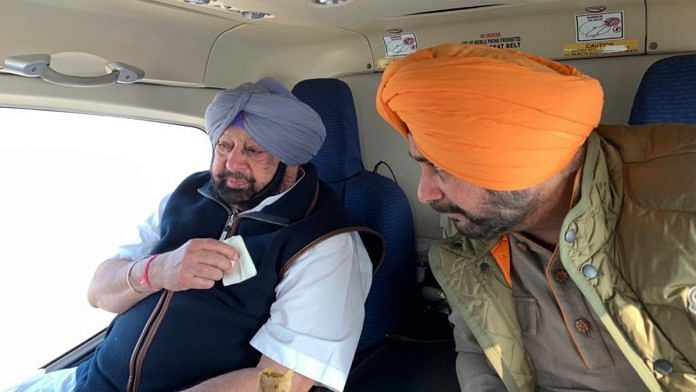The tussle between Captain Amarinder Singh and Navjot Singh Sidhu in Punjab betrays a puzzling weakness of the Congress — its inability to keep its house in order even in states where it is strong and in power.
While Navjot Sidhu is in Delhi to meet Rahul Gandhi and Priyanka Gandhi Vadra, the Punjab chief minister appeared before a three-member panel set up by the party high command to resolve differences between the two Congress leaders.
Amarinder Singh is perhaps the Congress’ strongest chief minister, and should be gearing up for the assembly election due in his state next year. But he is instead busy responding to summons of the top leadership and resolving petty intra-party conflicts.
Infighting in state units isn’t unusual for political parties. But the Congress seems to have made a habit of it. From Assam to Rajasthan, Madhya Pradesh to Punjab — there are plenty of examples of Congress vs Congress when the party is in power.
All this means only one thing — a disconnected high command unable to take timely and prudent decisions.
Many analysts have suggested that with the Gandhi family being unable to deliver national success, it should just play the role of mentor or holding company to many autonomous state-level Congress chapters. But even that doesn’t look like a sound option given how the family has compromised the stature of its successful regional readers.
Also read: What Sukhpal Khaira’s ghar wapsi to Congress says about Amarinder Singh’s politics
Crumbling when in power
The Congress’ situation in Punjab, a state the party won decisively and by defying the ‘Modi factor’ in 2017, is just a continuation of what seems to have become a perturbing paradigm for the party.
Circa 2015. In Assam, the Congress under stalwart Tarun Gogoi had been in power for three terms. It had everything going for it — a beloved veteran at the helm and an astute leader in Himanta Biswa Sarma, who understood mass politics and had administrative experience. And yet, the party couldn’t keep its act together. An unhappy Himanta Sarma stormed out and joined the Bharatiya Janata Party (BJP). Rest, as the cliche goes, is history.
The party, burdened by a string of losses and electoral marginalisation, found its much-needed booster shot in the 2018 December assembly elections, defeating a powerful BJP in three crucial states — Rajasthan, Madhya Pradesh, and Chhattisgarh.
But, the glory was short-lived. In two of those states, things soon began to unravel with key party leaders at loggerheads with each other. The Ashok Gehlot-Sachin Pilot saga in Rajasthan unfolded in the ugliest of ways, and destabilised the government. Tensions continue to simmer, even as the ‘will he, won’t he’ question about Pilot jumping ship seems to have become a perennial talking point.
In Madhya Pradesh, the party was unluckier. Bogged down by a Jyotiraditya Scindia unhappy at not being made the chief minister, the Kamal Nath-led Congress government eventually collapsed, with Scindia making a high-profile entry into the BJP.
The infighting in the Chhattisgarh Congress between chief minister Bhupesh Baghel and T.S. Singh Deo may not hit headlines, but is hardly a secret.
Punjab, therefore, is barely an aberration. In journalism, we say three makes a straight line. With Punjab, the Congress has smoothly established how being in power and yet crumbling has become its new normal.
Also read: Why Punjab CM Amarinder Singh is made to stand trial in Gandhi family court
A weak core
For political parties in power, especially in the Modi-Shah era, it is imperative to use their time to strengthen themselves. Because in opposition, it is always going to be an uphill task evading attacks from the ruling party and protecting your leaders from jumping ship to go where the grass is ‘greener’.
For the Congress, however, it seems to be working in reverse. Its chief ministers and state units are perpetually busy fighting instead of consolidating hold or preparing for future electoral battles, a travesty for a party reduced to 50-odd seats nationally, with chief ministers in just three states — Rajasthan, Punjab, and Chhattisgarh.
At the heart of this recurring crisis lies the inability of the Congress high command, read the Gandhis, to manage party affairs tactfully and effectively.
One, a weak central leadership impacts the thinking of state leaders, who rightly believe they are able to win elections on their merit and deserve what they want. Two, the Gandhis, over the past few years, have proved to be ineffective in managing diverse ambitions and desires of their leaders, resorting to playing favourites or dismissing their concerns.
In Assam, for instance, it was evident Rahul Gandhi wasn’t the biggest fan of Himanta and wanted to ensure the baton passed on to Tarun Gogoi’s son, Gaurav, in line with then-CM’s desire. A seasoned leadership, in control of the situation, ought to have found a way to walk the tightrope by pacifying both sides and ensuring everyone gets a fair share of the pie. But the situation was so poorly handled that the Congress ended up giving away its biggest asset in the region to the BJP, nicely gift-wrapped with a best wishes note.
Punjab is threatening to become another example of the party’s top leadership failing to reign in squabbling leaders in time. The Congress is anyway staring at a dark future. But by allowing even hard-earned wins to turn into pathetic losses, it is ensuring there is no light at the end of the tunnel.
Views are personal.
(Edited by Prashant Dixit)



